|
Author
|
Topic: [Discuss] NASA's Voyager planetary probes
|
Robert Pearlman
Editor Posts: 51833
From: Houston, TX
Registered: Nov 1999
|
 posted 07-06-2012 03:16 PM
posted 07-06-2012 03:16 PM
   
NASA's Voyager probes: questions and commentsThis thread is intended for comments and questions regarding the updates under: NASA's Voyager probes: milestones and updates. Launched in 1977, Voyager 1 and Voyager 2 are operating as part of the Voyager Interstellar Mission, an extended mission to explore the solar system outside the neighborhood of the outer planets. NASA's Voyagers are the two most distant active representatives of humanity and its desire to explore. |
Rick Boos
Member Posts: 851
From: Celina, Ohio
Registered: Feb 2000
|
 posted 07-06-2012 03:17 PM
posted 07-06-2012 03:17 PM
   
Isn't it amazing that the Voyager spacecrafts have traveled that many years and miles without colliding into something major? |
Blackarrow
Member Posts: 3677
From: Belfast, United Kingdom
Registered: Feb 2002
|
 posted 07-07-2012 09:32 AM
posted 07-07-2012 09:32 AM
  
Not really. Space is huge. Objects big enough to destroy or disable a space probe are very rare, even in the Asteroid Belt (as evidenced by the fact that no spacecraft has been destroyed or disabled while passing through it). |
Philip
Member Posts: 6246
From: Brussels, Belgium
Registered: Jan 2001
|
 posted 12-22-2012 10:47 AM
posted 12-22-2012 10:47 AM
   
This month the Voyager project is exactly 40 years old!In July 1972, NASA accepted the proposal and by mid December 1972, they signed the project agreement, appointed Harris Bud Schurmeier as project manager and assembled a science steering group headed by professor Edward Stone of the California Institute of Technology (Caltech). |
Robert Pearlman
Editor Posts: 51833
From: Houston, TX
Registered: Nov 1999
|
 posted 03-21-2013 05:21 AM
posted 03-21-2013 05:21 AM
   
Yesterday, the American Geophysical Union (AGU) put out a press release titled: Voyager 1 has Left the Solar System, Sudden Changes in Cosmic Rays Indicate This, understandably, resulted in a flurry of news articles reporting the milestone.Unfortunately, it was false. NASA's Voyager team soon issued its own statement, disputing the claim, pointing to their own announcement in December that Voyager had entered a new region of the solar system, called "the magnetic highway," where energetic particles change dramatically. The AGU then updated their release, with a new headline: Voyager 1 has entered a new region of space, sudden changes in cosmic rays indicate ...but the damage was already done; so don't be surprised if "Voyager has left the building solar system" articles float around the internet for years to come... |
moorouge
Member Posts: 2486
From: U.K.
Registered: Jul 2009
|
 posted 05-16-2013 02:37 PM
posted 05-16-2013 02:37 PM
   
All this begs the question - how does one define the solar system? |
Headshot
Member Posts: 1281
From: Vancouver, WA, USA
Registered: Feb 2012
|
 posted 09-12-2013 05:46 PM
posted 09-12-2013 05:46 PM
   
NASA's Voyager 1 spacecraft officially is the first human-made object to venture into interstellar space. I believe that Pioneers 10 and 11 were the first artificial objects to leave the solar system. They were both to have crossed Pluto's orbit around 1990, but were heading in opposite directions. We do not know exactly when that happened because we had lost radio contacts with them.Voyager 1 was the first object to leave the solar system with which we still had radio contact. |
Robert Pearlman
Editor Posts: 51833
From: Houston, TX
Registered: Nov 1999
|
 posted 09-12-2013 05:52 PM
posted 09-12-2013 05:52 PM
   
As of today, Pioneer 10 is 109.224 AU from the Sun, Pioneer 11 is 88.780 AU, Voyager 2 is 102.690 AU and Voyager 1 is 125.405 AU. Thus Voyager 1 is further out than either Pioneer and crossed into interstellar space first. |
Headshot
Member Posts: 1281
From: Vancouver, WA, USA
Registered: Feb 2012
|
 posted 09-12-2013 05:55 PM
posted 09-12-2013 05:55 PM
   
Thanks for the correction. That's a really cool site too. |
Blackarrow
Member Posts: 3677
From: Belfast, United Kingdom
Registered: Feb 2002
|
 posted 09-12-2013 07:58 PM
posted 09-12-2013 07:58 PM
  
Voyager 1: humanity's most distant reach. |
lspooz
Member Posts: 479
From: Greensboro, NC USA
Registered: Aug 2012
|
 posted 09-12-2013 08:36 PM
posted 09-12-2013 08:36 PM
   
NASA's Voyager has great info on the data analysis leading to the announcement, including an audio link demonstrating the 'pitch change' in vibrations measured in interstellar plasma versus solar plasma. |
Philip
Member Posts: 6246
From: Brussels, Belgium
Registered: Jan 2001
|
 posted 11-03-2013 12:10 PM
posted 11-03-2013 12:10 PM
   
Just wanted to point out this excellent commercial for Klara's Top 100 for classical music. |
cspg
Member Posts: 6359
From: Geneva, Switzerland
Registered: May 2006
|
 posted 01-16-2014 02:31 AM
posted 01-16-2014 02:31 AM
   
I like the idea that 25 years later, we still get some interesting pictures. See Astronomy Picture of the Day (APOD) for 1/16/14. A mere 148 kilometers across, diminutive Despina was discovered in 1989, in images from the Voyager 2 spacecraft taken during its encounter with the solar system's most distant gas giant planet. But looking through the Voyager 2 data 20 years later, amateur image processor and philosophy professor Ted Stryk discovered something no one had recognized before -- images that show the shadow of Despina in transit across Neptune's blue cloud tops. |
Blackarrow
Member Posts: 3677
From: Belfast, United Kingdom
Registered: Feb 2002
|
 posted 09-21-2015 05:36 PM
posted 09-21-2015 05:36 PM
  
I know that the Voyager 1 and 2 TV cameras were switched off to save power some years ago, but is either Voyager currently producing enough power to allow, say, one camera to be reactivated long enough to take a final picture of our distant sun as the Voyagers head out of the solar system? Or have the cameras chilled down below the point of recovery? |
Robert Pearlman
Editor Posts: 51833
From: Houston, TX
Registered: Nov 1999
|
 posted 09-21-2015 05:40 PM
posted 09-21-2015 05:40 PM
   
From NASA's Voyager FAQ: Can the Voyager imaging cameras be turned back on?It is possible for the cameras to be turned on, but it is not a priority for Voyager's Interstellar Mission. After Voyager 1 took its last image (the "Solar System Family Portrait" in 1990), the cameras were turned off to save power and memory for the instruments expected to detect the new charged particle environment of interstellar space. Mission managers removed the software from both spacecraft that controls the camera. The computers on the ground that understand the software and analyze the images do not exist anymore. The cameras and their heaters have also been exposed for years to the very cold conditions at the deep reaches of our solar system. Even if mission managers recreated the computers on the ground, reloaded the software onto the spacecraft and were able to turn the cameras back on, it is not clear that they would work. |
Blackarrow
Member Posts: 3677
From: Belfast, United Kingdom
Registered: Feb 2002
|
 posted 09-22-2015 04:48 PM
posted 09-22-2015 04:48 PM
  
I'll take that as a "no." A pity, but more or less what I expected. |
moorouge
Member Posts: 2486
From: U.K.
Registered: Jul 2009
|
 posted 10-18-2015 06:36 AM
posted 10-18-2015 06:36 AM
   
Back in the seventies two Voyager spacecraft were sent on a mission to explore our universe. They carried onboard a gold disc that contained a record of our planet and species so when found it would give the finder some idea of who we were and what our planet was like.Now, professor Chris Reilly at Lincoln University thinks that our world has changed so much that an update should be sent to the Voyagers while it is still possible. Because of the distance involved and power limitations, such a message can be only 1000 characters long. Reilly's suggestion is, "We hope that one day, in finding our Voyager you will know of our existence and our desire, like yours, to explore and better understand this universe we have shared with you. With peace and hope from the people of planet Earth." What message would you send? |
oly
Member Posts: 1464
From: Perth, Western Australia
Registered: Apr 2015
|
 posted 10-18-2015 08:49 AM
posted 10-18-2015 08:49 AM
   
What message would you send?How about "If found, please return to NASA, John F Kennedy Space Centre, Merritt Island, Florida, USA, Planet Earth"?
|
Blackarrow
Member Posts: 3677
From: Belfast, United Kingdom
Registered: Feb 2002
|
 posted 10-18-2015 04:21 PM
posted 10-18-2015 04:21 PM
  
"We are a peace-loving species, but we're also more powerful than you could possibly imagine. Honestly." |
moorouge
Member Posts: 2486
From: U.K.
Registered: Jul 2009
|
 posted 10-19-2015 02:38 AM
posted 10-19-2015 02:38 AM
   
"If you find this, please don't reply. There are far too many people on our planet who think that they are masters of all they survey. A reply will spoil their day." |
Blackarrow
Member Posts: 3677
From: Belfast, United Kingdom
Registered: Feb 2002
|
 posted 10-20-2015 05:07 PM
posted 10-20-2015 05:07 PM
  
On a more profound note (and I'm rapping my own knuckles): if the Voyagers avoid any significant space debris, those golden records could one day become the last surviving evidence of our species, our planet and our solar system. The little hairs on the back of my neck are rising. |
Lunar rock nut
Member Posts: 916
From: Oklahoma city, Oklahoma U.S.A.
Registered: Feb 2007
|
 posted 10-21-2015 06:57 AM
posted 10-21-2015 06:57 AM
   
quote:
Originally posted by Blackarrow:
"We are a peace-loving species, but we're also more powerful than you could possibly imagine. Honestly."
And we taste terrible!
|
Robert Pearlman
Editor Posts: 51833
From: Houston, TX
Registered: Nov 1999
|
 posted 10-27-2015 11:48 PM
posted 10-27-2015 11:48 PM
   
The last original Voyager engineer is retiring, CNN reports. The spacecraft was built in 1975 and has a computer from the Atari age. The last guy who truly understands how to program it is 80-year-old NASA engineer Larry Zottarelli. And he's retiring. ...Zottarelli has been on the Voyager mission since the day it launched: September 5, 1977. He works on Voyager's flight data systems, which have just 64 kilobytes of memory (0.000064 gigabytes) and run a long-since retired computer language. |
Jay Gallentine
Member Posts: 289
From: Shorewood, MN, USA
Registered: Sep 2004
|
 posted 11-03-2015 08:41 PM
posted 11-03-2015 08:41 PM
   
A JPL source once told me of an obscure event in the Voyager flights known as the "Zottarelli Gap."Apparently, after the flights were underway, Larry Zottarelli had approached mission managers to advise them of a brief break in communications which would happen at a specific day and time. There was some cosmic/astronomical reason for this, and Zottarelli had worked out the exact time parameters of the event. And thus occurred the Zottarelli Gap. |
Robert Pearlman
Editor Posts: 51833
From: Houston, TX
Registered: Nov 1999
|
 posted 07-31-2017 07:11 PM
posted 07-31-2017 07:11 PM
   
NASA release First and Farthest: How the Voyagers Blazed TrailsFew missions can match the achievements of NASA's groundbreaking Voyager 1 and 2 spacecraft during their 40 years of exploration. Here's a short list of their major accomplishments to date. Planetary Firsts Launched in 1977, the Voyagers delivered many surprises and discoveries from their encounters with the gas giants of the outer solar system: Jupiter, Saturn, Uranus and Neptune. Between 1977 and 1990, the mission attained these distinctions: - First spacecraft to fly by all four planets of the outer solar system (Voyager 2)
- First mission to discover multiple moons of the four outer planets (both spacecraft):
- 3 new moons at Jupiter
- 4 new moons at Saturn
- 11 new moons at Uranus
- 6 new moons at Neptune
- First spacecraft to fly by four different target planets (Voyager 2)
- First spacecraft to visit Uranus and Neptune (Voyager 2)
- First spacecraft to image the rings of Jupiter, Uranus and Neptune (Voyager 2)
- First spacecraft to discover active volcanoes beyond Earth (on Jupiter's moon Io -- Voyager 1)
- First spacecraft to detect lightning on a planet other than Earth (at Jupiter -- Voyager 1)
- First spacecraft to find suggestions of an ocean beyond Earth (at Jupiter's moon Europa — both spacecraft)
- First spacecraft to detect a nitrogen-rich atmosphere found beyond our home planet (at Saturn's moon Titan — Voyager 1)
Heliophysics FirstsAfter Voyager 1 departed from Saturn in November 1980, it began a journey to where no human-made object had ever gone before: the space between the stars. On August 25, 2012, it crossed over into interstellar space, leaving behind the heliosphere — the enormous magnetic bubble encompassing our Sun, planets and solar wind. Voyager 2 set course for interstellar space after departing from Neptune in August 1989, and is expected to enter interstellar space in the next few years. Together the Voyagers have taught us a great deal about the extent of our sun's influence and the very nature of the space that lies beyond our planets. - First spacecraft to leave the heliosphere and enter interstellar space (Voyager 1)
- First spacecraft to measure full intensity of cosmic rays — atoms accelerated to nearly the speed of light — in interstellar space (Voyager 1)
- First spacecraft to measure magnetic field in interstellar space (Voyager 1)
- First spacecraft to measure density of interstellar medium — material ejected by ancient supernovae (Voyager 1)
- First spacecraft to measure solar wind termination shock -- the boundary where solar wind charged particles slow below the speed of sound as they begin to press into the interstellar medium (Voyager 2)
Engineering and Computing Firsts and RecordsThe Voyagers, which launched with nearly identical configurations and instruments, were designed to withstand the harsh radiation environment of Jupiter — the greatest physical challenge they would ever encounter. Preparations for the peril at Jupiter ensured that the Voyagers would be well equipped for the rest of their journeys, too. Engineering and computing advances that the Voyagers debuted set the stage for future missions. - First spacecraft extensively protected against radiation, which also set the standard for radiation design margin still in use for space missions today
- First spacecraft protected against external electrostatic discharges
- First spacecraft with programmable computer-controlled attitude and articulation (which means the pointing of the spacecraft)
- First spacecraft with autonomous fault protection, able to detect its own problems and take corrective action
- First use of Reed-Solomon code for spacecraft data — an algorithm to reduce errors in data transmission and storage, which is widely used today
- First time engineers linked ground communications antennas together in an array to be able to receive more data (for Voyager 2's Uranus encounter)
Beyond that, the Voyager spacecraft continue setting endurance and distance records: - Longest continuously operating spacecraft (Voyager 2, which passed Pioneer 6's record on Aug. 13, 2012)
- Most distant spacecraft from the Sun (Voyager 1, which passed Pioneer 10's distance on Feb. 17, 1998 and is currently about 13 billion miles, or 21 billion kilometers, away)
|
Robert Pearlman
Editor Posts: 51833
From: Houston, TX
Registered: Nov 1999
|
 posted 08-31-2017 07:17 PM
posted 08-31-2017 07:17 PM
   
The New York Times Magazine shares the story of the Voyager flight-team engineers, 40 years on... For the foreseeable future, Voyager seems destined to remain in the running for the title of Mankind’s Greatest Journey, which might just make its nine flight-team engineers — most of whom have been with the mission since the Reagan administration — our greatest living explorers. They also may be the last people left on the planet who can operate the spacecraft’s onboard computers, which have 235,000 times less memory and 175,000 times less speed than a 16-gigabyte smartphone. And while it’s true that these pioneers haven’t gone anywhere themselves, they are arguably every bit as dauntless as more celebrated predecessors. Magellan never had to steer a vessel from the confines of a dun-colored rental office, let alone stay at the helm long enough to qualify for a senior discount at the McDonald’s next door. |
Robert Pearlman
Editor Posts: 51833
From: Houston, TX
Registered: Nov 1999
|
 posted 09-05-2017 07:00 PM
posted 09-05-2017 07:00 PM
   
collectSPACE 40 years out, NASA's twin Voyager probes inspire Golden Record revivalsForty years after NASA launched a pair of robotic probes on journeys out into our solar system and beyond, the messages the spacecraft carried about us still resonate here on Earth, and as dispatches going out in space. The "Golden Record," which is mounted to both Voyager 1 and Voyager 2, convey sounds, images and greetings from the people of planet Earth on the chance that some distant extraterrestrial intelligence will one day intercept one of the probes. Now, four decades after the records were sent into space, artists who were associated with the original discs' creation, and an actor who had a fictional encounter with a Voyager probe on film, have launched projects to celebrate the Golden Record, extending its basic premise to another mission and bidding farewell to the Voyagers themselves. 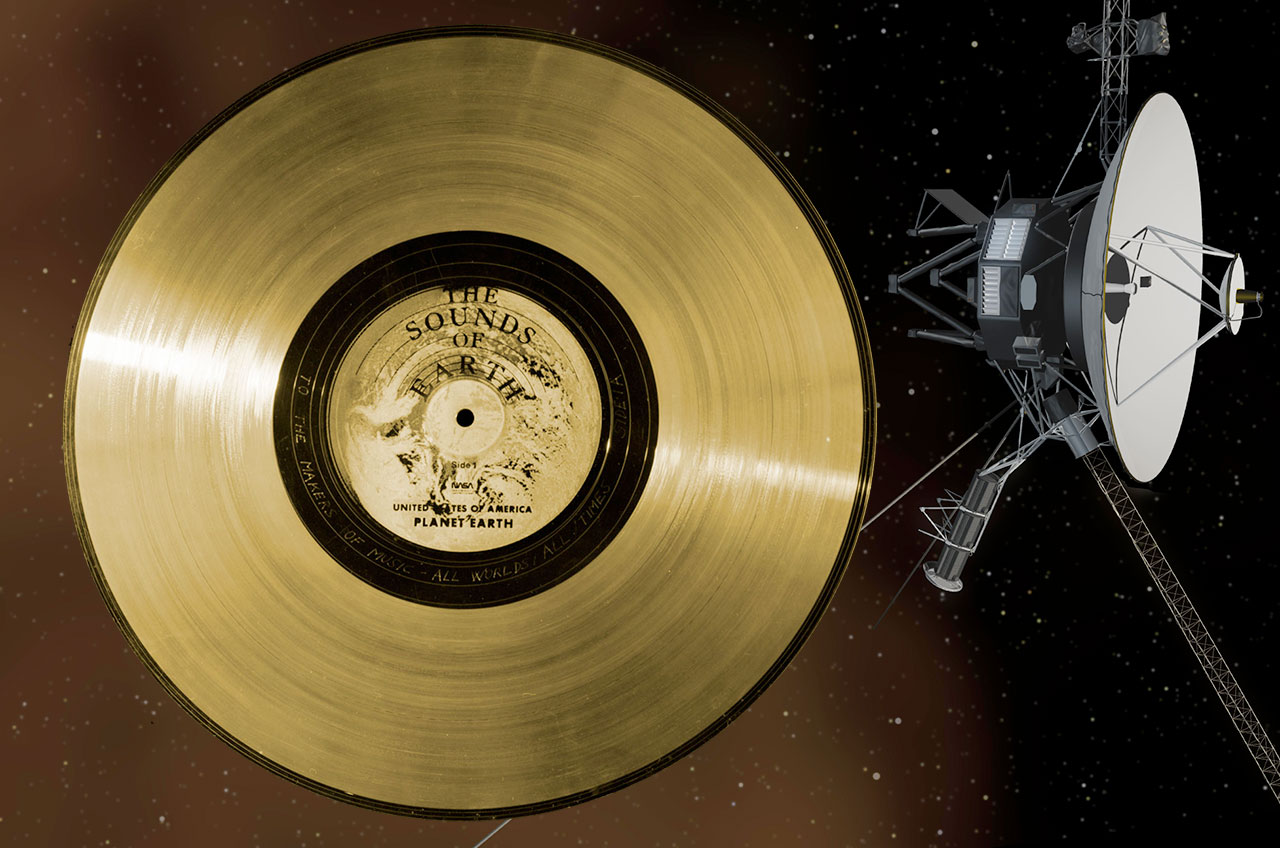 |
Mike Dixon
Member Posts: 1625
From: Kew, Victoria, Australia
Registered: May 2003
|
 posted 12-01-2017 06:04 PM
posted 12-01-2017 06:04 PM
   
...a set of thrusters aboard the Voyager 1 spacecraft successfully fired up Wednesday after 37 years without use. Simply staggering after all this time. |
moorouge
Member Posts: 2486
From: U.K.
Registered: Jul 2009
|
 posted 12-02-2017 02:06 AM
posted 12-02-2017 02:06 AM
   
quote:
Originally posted by Philip:
In July 1972, NASA accepted the proposal and by mid December 1972, they signed the project agreement, appointed Harris Bud Schurmeier as project manager and assembled a science steering group headed by professor Edward Stone of the California Institute of Technology (Caltech).
According to Carl Sagan in his book "Pale Blue Dot," the mission was conceived in the late 60's and was first funded in 1972.It's worth remembering that it was only after the reconnaissance of Jupiter had been completed — the original objective — was approval given for the mission to be extended to the outer planets. From launch to Neptune encounter the programme cost each American less than a penny a year. Sagan records also that but for the direct intervention of former astronaut Richard Truly, the then NASA Administrator, the picture of our family of planets would never have received the funding necessary. The people who actually worked out and designed the command sequence and exposure times were Candy Hansen (JPL) and Carolyn Porco (Univ. Arizona). |
Robert Pearlman
Editor Posts: 51833
From: Houston, TX
Registered: Nov 1999
|
 posted 04-09-2018 02:48 AM
posted 04-09-2018 02:48 AM
   
From photojournalist Pauline Acalin on Twitter: Soooo, uhhh, JPL "found" this relic "in a closet" while looking for things they could display at Yuri's Night. It's Serial Number 01 of the Narrow Angle Camera on Voyager 1. All the image testing was done using this exact lens. 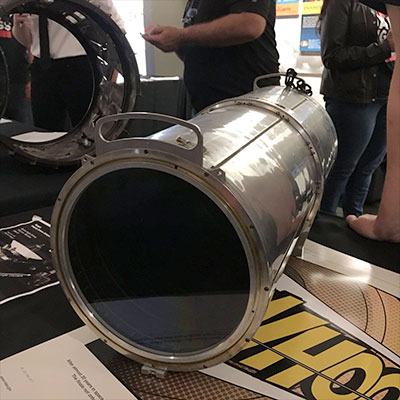 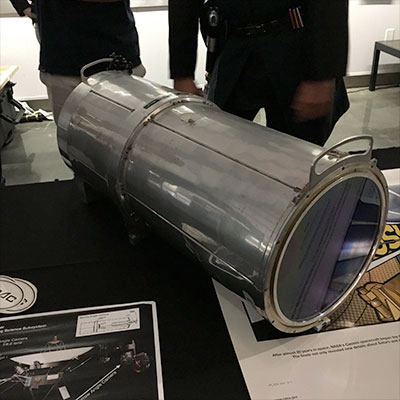
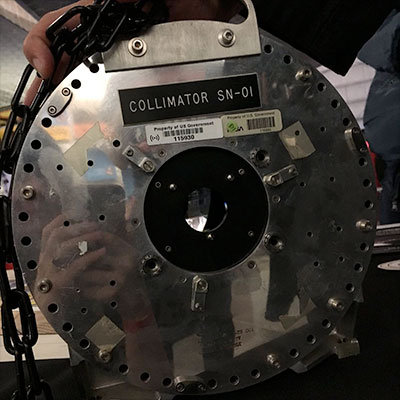
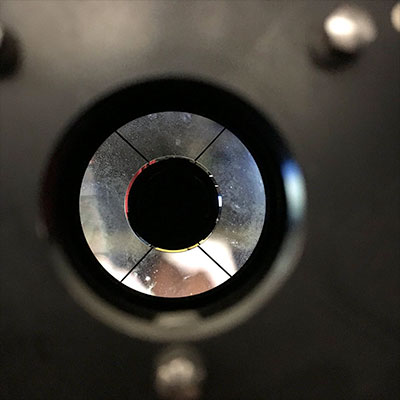
|
SkyMan1958
Member Posts: 1348
From: CA.
Registered: Jan 2011
|
 posted 10-05-2018 05:46 PM
posted 10-05-2018 05:46 PM
   
It seems to me that this recent (drawn) picture of Voyager 2 near the edge of the Heliopause has some issues. Most notably it shows the Heliosphere streaming out behind the Sun, somewhat like the magnetic field around the Earth after it is affected by the Solar Wind. This streaming out of the Heliosphere does not seem logical, as the Heliosphere should theoretically be affected on all sides equivalently, since it is cosmic rays etc. that are pushing against the Heliosphere. I would expect a more spherical Heliosphere. 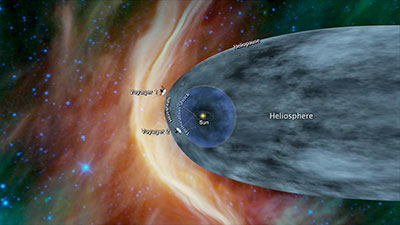 |
Robert Pearlman
Editor Posts: 51833
From: Houston, TX
Registered: Nov 1999
|
 posted 10-05-2018 05:58 PM
posted 10-05-2018 05:58 PM
   
Here is a NASA infographic that explains why the heliosphere is represented the way it is. Relevant to this discussion: As the heliosphere travels through the interstellar medium, it leaves a long heliotail in its wake wave, much like a boat travelling through the water. |
SkyMan1958
Member Posts: 1348
From: CA.
Registered: Jan 2011
|
 posted 10-05-2018 06:29 PM
posted 10-05-2018 06:29 PM
   
Thank you Robert!It seems to me that given the velocity of the Sun relative to the center of the Milky Way, approximately 514,000 mph, is relatively small compared to the speed of light, this effect would be minimal. Still, I guess there would be some shortening in the direction of the Sun's travel, and some lengthening behind the Sun. It also could be that the artist significantly exaggerated the effect to illustrate it. |
Robert Pearlman
Editor Posts: 51833
From: Houston, TX
Registered: Nov 1999
|
 posted 12-10-2018 09:00 AM
posted 12-10-2018 09:00 AM
   
Voyager 2 has followed Voyager 1 into interstellar space. Comparing data from different instruments aboard the trailblazing spacecraft, mission scientists determined the probe crossed the outer edge of the heliosphere on Nov. 5, 2018. This boundary, called the heliopause, is where the tenuous, hot solar wind meets the cold, dense interstellar medium. Its twin, Voyager 1, crossed this boundary in 2012, but Voyager 2 carries a working instrument that will provide first-of-its-kind observations of the nature of this gateway into interstellar space.Voyager 2 now is slightly more than 11 billion miles (18 billion kilometers) from Earth. |
Blackarrow
Member Posts: 3677
From: Belfast, United Kingdom
Registered: Feb 2002
|
 posted 12-10-2018 07:53 PM
posted 12-10-2018 07:53 PM
  
Voyager 2 now is slightly more than 11 billion miles from Earth. Far out, man! |
Mike Dixon
Member Posts: 1625
From: Kew, Victoria, Australia
Registered: May 2003
|
 posted 07-08-2019 11:25 PM
posted 07-08-2019 11:25 PM
   
The engineers' plan to manage power and aging parts should ensure that Voyager 1 and 2 can continue to collect data from interstellar space for several years to come. They've been simply incredible ambassadors. Kids in high school when they were launched would now be contemplating retirement. |
Blackarrow
Member Posts: 3677
From: Belfast, United Kingdom
Registered: Feb 2002
|
 posted 01-29-2020 04:35 PM
posted 01-29-2020 04:35 PM
  
From this NASA release: Engineers for NASA's Voyager 2 spacecraft are working to return the mission to normal operating conditions after one of the spacecraft's autonomous fault protection routines was triggered. I feel your pain, old-timer! Occasionally, one of my autonomous fault protection routines is triggered and I go "Ouch!" |
Headshot
Member Posts: 1281
From: Vancouver, WA, USA
Registered: Feb 2012
|
 posted 04-22-2023 11:18 AM
posted 04-22-2023 11:18 AM
   
Just as a useless bit of trivia. On or around August 31st of this year Voyager 2 should "overtake" Pioneer 10 and become the second farthest man-made object from the Sun.Around this time both Pioneer 10, which fell silent years ago, and Voyager 2 will be about 134.28 AUs from the Sun. Of course Voyager 1 is the farthest by a long shot. |
NukeGuy
Member Posts: 110
From: Irvine, CA USA
Registered: May 2014
|
 posted 04-27-2023 09:26 PM
posted 04-27-2023 09:26 PM
  
From a NASA release: Both Voyager probes power themselves with radioisotope thermoelectric generators (RTGs), which convert heat from decaying plutonium into electricity... Nuclear power. When you care to send the very best. |
Robert Pearlman
Editor Posts: 51833
From: Houston, TX
Registered: Nov 1999
|
 posted 02-07-2024 08:38 AM
posted 02-07-2024 08:38 AM
   
From the Jet Propulsion Laboratory (JPL) via X: A Voyager update: Engineers are still working to resolve a data issue on Voyager 1. We can talk to the spacecraft, and it can hear us, but it's a slow process given the spacecraft's incredible distance from Earth. We’ll keep you informed on its status. |

















